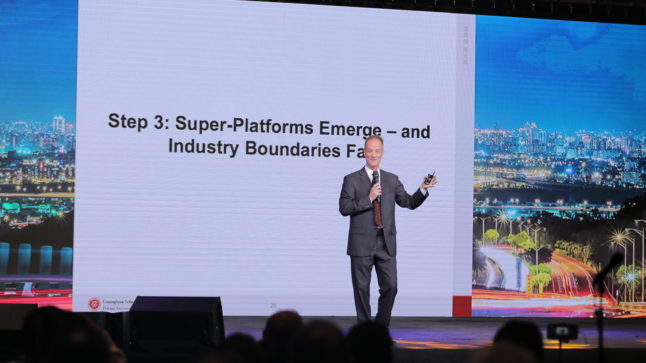I like cheetahs. I’m not totally sure why. But I have watched every documentary I can find about them. I have studied their biology. I frequently go to see them in the wild in Kenya and South Africa. I just think they are really cool.
And I also recall Berkshire Hathaway Vice-Chairman Charlie Munger talking about how business is an ecosystem like nature. And in both, hyper-specialization seems to be the key for long-term survival and success. For example, giraffes have their long necks to reach the high leaves. Turtles have their protective shells. Birds are singularly evolved for flight. And cheetahs are built for speed and acceleration.
It’s about hyper-specialization. You don’t evolve to do 3-4 things well. Animals don’t have wings, a long neck and a shell. They evolve to do 1-2 things really, really well. And to do that, they give up lots of other things.
A cool cheetah factoid: They can go from zero to 60 mph in three strides (and in about 3 seconds). Cheetahs are specialized for acceleration as much as top speed.
A couple thoughts on cheetahs and how hyper-specialization benefits businesses.
1: Companies that prosper long-term are hyper-specialized in 1-2 activities. Know what 1-2 skills you will survive and thrive based on.
What I find fascinating is how most every part of a cheetah’s anatomy is adapted for speed and acceleration. Their claws don’t retract like the other big cats, so they can be used like cleats when running. The tail is a counter-weight for making sharp turns. And their collarbones don’t attach to the spine. They sort of sit on top of the muscle. That enables a longer stride.
How many businesses can you think of where almost every structural aspect is specialized toward just 1-2 key activities?
For me, one company that comes to mind is Costco, which is specialized for low costs. They operate as a warehouse – and have basically eliminated the retail step in the supply chain. In their warehouse / store, they load the goods on the shelves while still on palettes (and with forklifts). They buy and sell in big bulk quantities. They are located on the edge of town where real estate is cheaper. They even use skylights so they can save money on lighting. From top to bottom, the business is hyper-specialized to be cheap.
Another example is fast-fashion giant Zara, which I wrote about here. Zara is hyper-specialized for rapid design, production, and distribution. From their Spain HQ, they can track and re-mix a large percentage of the merchandise in their stores on a weekly basis. And they can design and distribute new products to their stores in weeks. That is very different than traditional fashion retail where a season’s merchandise is order months in advance. And requires a lot of demand projection.
2: Hyper-specialization means giving up other abilities and activities. And customers and products. Cheetah-like businesses are able to say no quickly.
Cheetahs gave up a lot for their acceleration. They are the lightest of the big cats and have limited jaw and body strength. They are mostly too small to go after zebras (well, not alone anyways). They can only really run at top speed for about 17 seconds before they over-heat. They can’t even really roar like the other big cats. They kind of chirp.
I think you have the same trade-offs in hyper-specialized business. If you want to be a discount airline, you have to get rid of the expensive hub-and-spoke operations and multiple aircraft types. You have to give up lots of routes. And you have to give up certain types of customers. Starbucks, another favorite company, resists the idea of selling most anything but coffee and other drinks loaded with caffeine and sugar. No real sandwiches. No kitchen. A management consultant friend used to always tell me that you could tell who had a clear strategy by how quickly they could say “no” to something.
3: Hyper-specialization is only an advantage in certain market niches and against certain competitors. Know your niche.
You’ll note that cheetahs focus on gazelles, the one prey that the other big cats usually can’t catch. Being hyper-specialized is the most valuable when it gives you an advantage over your competitors and against a specific customer or market niche. Being a super-fast cat isn’t really an advantage against rabbits. You can catch them but so can lots of other animals (plus they go into holes). You have to know where your niche gives you an advantage over others.
For example, Costco competes against supermarkets and discounters like Walmart. But their low-cost, buy-in-bulk warehouse approach really only works for consumer staples that can be bought in larger amounts. And for customers who have cars and can drive out to their stores (and can carry all the goods home). For this specific product set and market niche, Costco is much cheaper than competitors. But they don’t have the same cost advantage in things like fresh fruits and lattes. Costco can’t really compete with Whole Foods.
Similarly, Zara wins because it attracts women to their stores with frequent fashion refreshes – and by offering these fashions at relatively cheap prices. So when compared to competitors like Gucci and Prada, Zara is much cheaper (“fashion for everyone”.) And when compared to department stores and discounters, Zara is more fashionable and always has the latest trends. So fast fashion works well in this situation. But it doesn’t work with fashion ignorant customers (men?) or in products like perfume which don’t update often.
4: Even with a clear competitor and market niche, hyper-specialization still only works in specific circumstances.
The cheetah can only run fast for about 17 seconds. And the gazelle can run pretty fast for much longer. So the cheetah has to catch the gazelle within that time frame. In practice, it means it only catches the gazelle if it can sneak in close enough before it makes its charge. Cheetahs succeed in this about 3 out of 4 times, which is really high for predators (note: when tigers charge, they only win about 1 in 20 times.).
So this is about probabilities. And therefore, the specific conditions matter. For example, cheetahs struggle in the dry season because the grass dies and they can’t sneak in close enough without being spotted. This is why tigers hide in the jungle near water.
It’s the same in business. You have your hyper-specialization. You know the 1-2 things you are giving up everything to achiever. And you know your customer niche and the competitor you are beating with your specialization. But you want to focus on a couple specific scenarios where you have the highest probabilities of success.
For example, a Costco store needs a certain customer volume before its “unit cost per transaction” drops below its competitors. It lots of people nearby with cars. So it doesn’t work in areas without enough urban density. Or in cities where people don’t own cars. Similarly, Zara is dependent on getting good locations in good shopping centers. Their fast-fashion stores don’t work unless fashion-conscious consumers are already strolling by all day. And so on. You have to know the situation where your strategy has the highest probability of success.
***
A final point.
I often ask my students “what one activity does this business do much better than anyone else?” Or “who is the cheetah in this industry?”
And usually the answer is “nobody is the cheetah”. Most companies aren’t hyper-specialized, which is consistent with most companies not having any real competitive advantage either.
The majority of companies, such as restaurants and boutique retailers, are doing pretty much the same set of activities as lots of other companies. They’re all doing merchandising, sales / marketing, inventory management, and other stuff. To me, these companies look part-lion, part-bird and part-fish. they rise and they fall. It’s not surprising that they aren’t dominating a particular niche in the ecosystem long-term.
A simplest explanation for competitive advantage is when you are competing on a different set of activities than others. If you don’t have one, then you are basically just trying to do the same activities as others, but better.
Ok. That’s enough of my diversion into animal stuff.
Cheers, -jeff
———-
I write, speak and consult about how to win (and not lose) in digital strategy and transformation.
I am the founder of TechMoat Consulting, a boutique consulting firm that helps retailers, brands, and technology companies exploit digital change to grow faster, innovate better and build digital moats. Get in touch here.
My book series Moats and Marathons is one-of-a-kind framework for building and measuring competitive advantages in digital businesses.
Note: This content (articles, podcasts, website info) is not investment advice. The information and opinions from me and any guests may be incorrect. The numbers and information may be wrong. The views expressed may no longer be relevant or accurate. Investing is risky. Do your own research.

